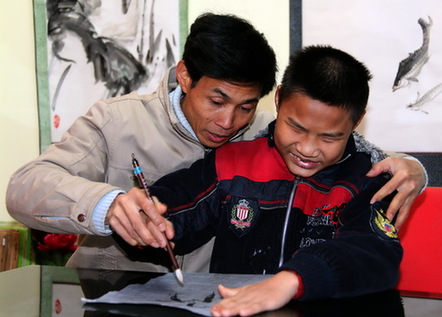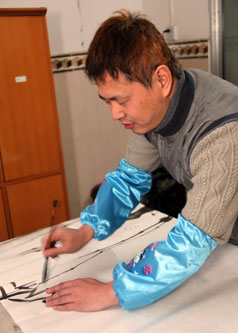People
Coloring the darkness
Updated: 2011-02-16 07:53
By Zhang Zixuan (China Daily)
|
 Zeng Bailiang helps Han Ping'an, a 14-year-old boy with visual impairment, learn Chinese ink painting. Huo Yan / China Daily |
A teacher helps students with visual disabilities create stunning artworks. Zhang Zixuan reports.
Zeng Bailiang asks his students to paint by smell. For yellow, he tells them to use the lemon-scented paint, for green, the one that smells of grass, and for red, the one with the fragrance of roses. Zeng added the fragrances to the pigments to enable his painting students with visual impairments find their way around their palettes.
"We overly trust what we see, but the blind use other senses to awaken their imaginations and set their minds free," says Zeng, who has tutored more than 32,000 visually impaired people in Chinese ink painting over the past 30 years.
He got the idea from a seemingly miraculous 1971 encounter when the then 12-year-old was practicing still-life painting in the countryside.
|
 Tao Jin, a 46-year-old artist who was born blind, started learning painting from Zeng Bailiang in 1996. Huo Yan / China Daily |
"Why not paint that bird over there with the long beak and green back?" a 4-year-old boy, who was standing behind him said, pointing to a plant a few steps away.
Zeng looked but didn't see any bird. He walked closer to the plant and pushed aside its branches to reveal a bird that looked exactly as the boy had described standing exactly where he had said it was.
Zeng was shocked, because the boy was blind.
"It's just there. I can feel it," the boy explained.
That sentence changed Zeng forever. He says he can't articulate exactly what the experience meant to him.
But, he says, he "seemed to suddenly understand a certain openness and relativity that he read about in traditional Chinese philosophy books".
So he began instructing people with visual impairments in painting, hoping to guide people with blindness, "out of the dark", he says.
"If blind people can paint, what can't they do?" says Zeng, who is also vice-chairman of the Nanning Artists Association and former deputy director-general of the Nanning Disabled Persons' Federation in the Guangxi Zhuang autonomous region's capital.
Zeng's first painting class for people with visual impairments was solely to help the students gain confidence.
He organized a needle threading competition between his blind students and those who can see. It turned out the blind could thread needles much faster thanks to a more sensitive sense of touch.
"What seems necessary sometimes really isn't," Zeng says.
The "atypical" teacher takes his students into nature so they can know more about such objects as leaves and flowers through touch.
He also has them feel potted landscapes and stones to imagine the shapes of large trees and mountains.
Zeng teaches his students with visual impairments how to place every brush stroke in the right place by putting differently shaped stones on paper as reference points.
|
 A painting by Han Ping'an. provided to China Daily |
Tao Jin, a 46-year-old who was born blind, began to learn Chinese ink painting from Zeng in 1996. Tao recalls that he thought Zeng was insulting him when the instructor volunteered to teach Tao how to paint.
But Tao was touched by Zeng's sincerity and picked up the paintbrush with a shaking hand. While painting the first hill in his life, Tao had no idea where the next brushstroke should be placed. It was as if he was walking helplessly through a boundless space, he says.
"The mountain you just painted is so magnificent!" Zeng told Tao.
Tao says he suddenly realized "what confidence was". And he fell in love with painting at that moment.
Zeng didn't tell Tao what his maiden work really looked like until many years later. He also didn't tell his student that, many times, his brush didn't even touch the paper.
What Zeng did tell Tao was how to control the amount of water added to the ink.
Tao recalls that Zeng once tried to teach him what transparency was. He grabbed Tao's right index finger and stuck it through the paper.
"This is transparency," Zeng told Tao.
"Painting enables me to experience a new life, and Zeng is my beacon of light," says Tao, who has become an acclaimed artist and the chairman of the Guangxi Association of the Blind.
In 1989, Zeng founded a free training school to help more people with disabilities.
More than 32,000 blind students like Tao have since received Chinese ink painting training. Many have become professional artists, whose works have been exhibited in such countries as the United Kingdom, Japan, Germany and the United States.
Zeng also encourages students to become involved in charity. They have sold their paintings to raise money for victims of the 2008 Wenchuan earthquake and the needy children of Project Hope.
The instructor hopes his students can perform at the 2012 London Paralympics' opening ceremony to let the whole world witness the miracle of his blind painting students.
"Respect is even more important than love," Zeng says.
"I'm not just teaching them painting. I'm helping them respect themselves and win respect from others."
E-paper

Ear We Go
China and the world set to embrace the merciful, peaceful year of rabbit
Preview of the coming issue
Carrefour finds the going tough in China
Maid to Order
Specials

Mysteries written in blood
Historical records and Caucasian features of locals suggest link with Roman Empire.

Winning Charm
Coastal Yantai banks on little things that matter to grow

New rules to hit property market
The State Council launched a new round of measures to rein in property prices.
